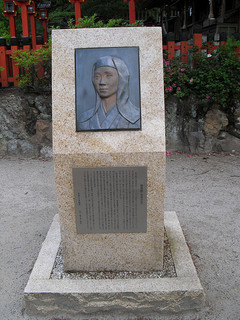Keishoin
- Born: 1628
- Died: 1705
- Childhood Name: 玉 (Tama)
- Other Names: お玉の方 (O-Tama no kata)
- Japanese: 桂昌院 (Keishouin)
Keishôin was a member of the Ôoku of Shogun Tokugawa Iemitsu, and mother of Tokugawa Tsunayoshi.
She was born in 1628, the second daughter of a Nishijin grocer. In her childhood, she was called Tama. She was later adopted by Honjô Munetoshi, steward for Kanpaku Nijô Mitsuhira. Traveling to Edo as the result of some interaction or connection with O-Ume, daughter of Rokujô Yûjun (a member of the Ôoku), Tama entered the Ôoku herself as a concubine of Shogun Tokugawa Iemitsu, and eventually gave birth to Tokugawa Tsunayoshi, who would grow up to be Shogun himself. After Tsunayoshi became Shogun in 1680, she took up residence in the san-no-maru (third bailey) of Edo castle, and came to be known as San-no-maru-dono as a result.
A private temple was established for her in Edo in 1682; this would later become the Edo Gokoku-ji. Keishôin was also involved in the construction of Zenkô-ji, a fifteen-year project.[1]
In 1702, she rose to the Junior First Rank, and many members of her family, beginning with her (adoptive) younger brother Honjô Munesuke, enjoyed the benefits of serving as direct shogunal vassals. It was around this time that her Buddhist devotion grew stronger, and she eventually took on the Buddhist name Keishôin.
She died in 1705, at the age of 79.
References
- "Keishôin." Sekai daihyakka jiten 世界大百科事典. Hitachi Solutions, 2012.
- Plaque at Imamiya Shrine, Kyoto.
- ↑ Anne Walthall, "Hiding the shoguns: Secrecy and the nature of political authority in Tokugawa Japan," in Bernard Scheid and Mark Teeuwen (eds.) The Culture of Secrecy in Japanese Religion, Routledge (2006), 347-348, 353n28.
